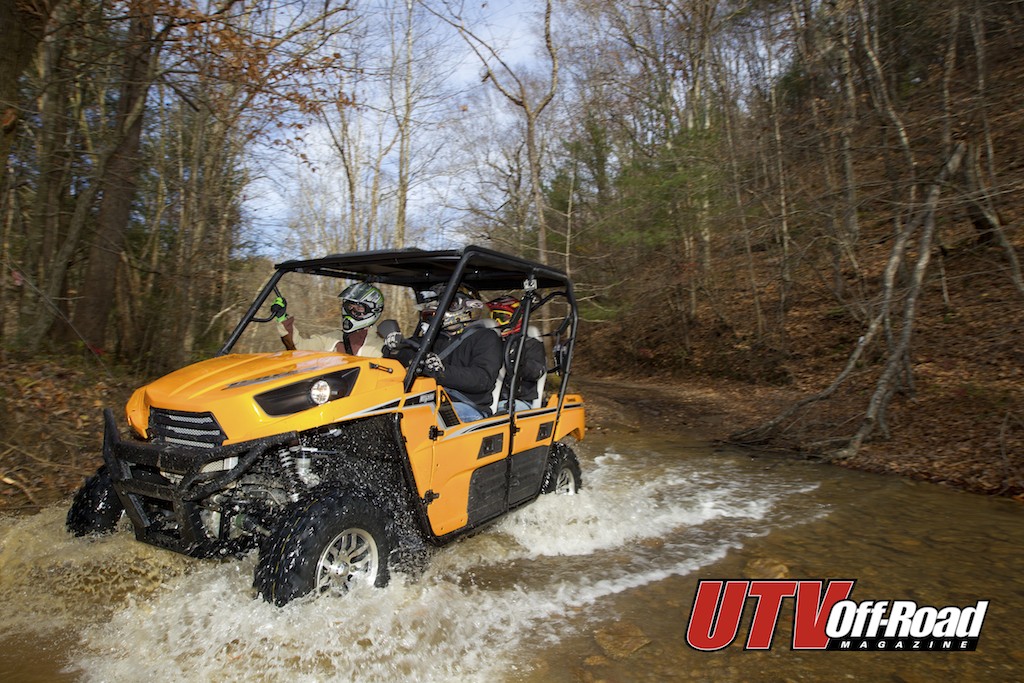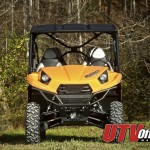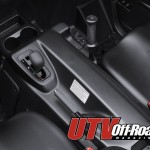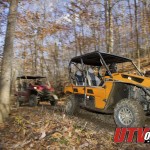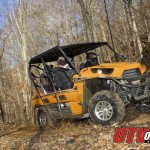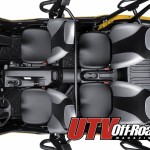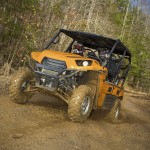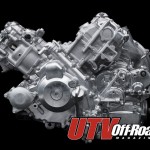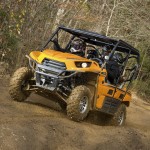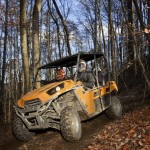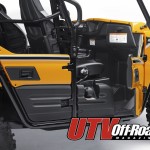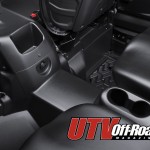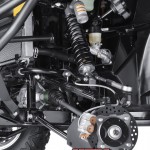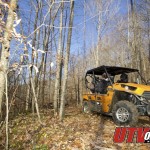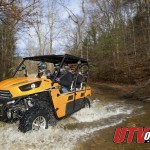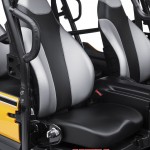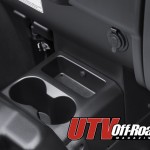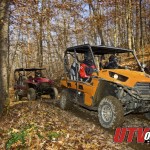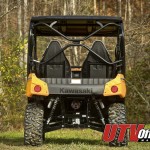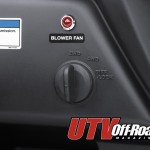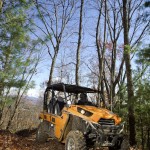Kawasaki adds to their lineup with a four seater built for the Adventure.
Whenever a new UTV is introduced into the market, it is exciting times for the media as well as the consumers. It opens more options for us to choose from and really get the right machine for the type of terrain you frequently ride on. In the last year, manufacturers seem to be in an all-out battle to build the next great machine that will appeal to a broad audience of off-road enthusiasts. Well, after driving the latest and greatest creations, we can honestly say that there is not one vehicle that fit the bill for everyone. As each new vehicle comes out, we’ve seen how they fit into a particular niche, they work well within that niche and beyond. Kawasaki has been hard at work and surprised us this year with the introduction of the all-new Teryx4. To be honest, we thought we would see a long travel version of Kawasaki’s Teryx before a 4-seater. We knew that they had something in the works, and gathered intel accumulated before the T4’s release had our long-travel ideas put on the back burner.
If you’re thinking the Teryx4 is just a stretched version of the Teryx with longer driveshafts and two more seats, you couldn’t be further from right. Very few pieces actually carry over — some drivetrain components, the steering wheel, and a few interior parts are from the two-seat Teryx. The hood, while it carries over the same visual from the two-seater, is a new mold. Kawasaki started fresh, designing a purpose-built 4-seat UTV from the ground up. It seems to be slated somewhere between a Ranger Crew and an RZR 4 — it’s neither a hauler nor a long-travel sport machine. So where does it fit?
FRAME-OFF
Kawasaki started with a CAD-designed dual box frame structure, using twin X braces in the frame boxes to increase rigidity. The 86.1-inch wheelbase is a staggering 16.9 inches shorter than the RZR 4’s, which allows for a tighter turning radius — 16.7 feet to be exact (the same as a Ford Mustang). You may think this equates to less interior room. Well, you’d be wrong. Surprisingly, the Teryx4 has more room in nearly every dimension than the RZR 4, especially hip and shoulder room. Rear-seat leg room is much more generous, and the wide, comfortable high-back bucket seats are wider as well. Kawasaki designed the roll cage to meet rigorous Earth-moving equipment ROPS standards, meaning it’s insanely stout.
LONG….ER TRAVEL
Up front, the T4 uses the same suspension setup as the standard two-seat unit, albeit with different shocks that allow 0.3 inches more travel, for a total of 7.8”. Out back, a new dual A-arm setup provides 8.3 inches of travel, up almost an inch from the two-seat model. On base Teryx4s, gas-charged shocks come equipped up front that are only preload adjustable, but rear shocks are fully-adjustable piggyback units. On EPS and LE models, the fronts get the piggyback and full adjustment treatment as well. At static, unloaded ride height, the Teryx4 offers up 10.8 inches of ground clearance. Load it up, and that number drops dramatically.
PONY UP
With more weight, you need more power. Since Kawi’s EFI-fed V-twin 750 in the standard Teryx wasn’t enough to haul around the extra heft, they went back to the drawing board with the new motor. Using an almost completely redesigned engine featuring an oil-bathed centrifugal clutch before the CVT transmission, the Teryx4 offers a smooth, easy-to-manipulate power character. The engine’s redesigned cylinder heads and camshafts offer up 15% more power than the previous V-twin. Feeding the engine is a new under-hood-mounted air intake with snorkel, which decreases sound levels in the cab dramatically. Equal-length exhaust headers ensure plenty of torque, and the EFI system features new 12-hole injectors for a finer fuel charge that increases engine response and cold starting capabilities. The EFI system easily compensates for altitude and temperature changes, and ran smoothly during all our testing.
SLOW IT DOWN
The Teryx4 uses a partially redesigned braking system. Up front, twin-piston calipers squeeze 200mm disc brakes, and they offer a good amount of bite considering the T4’s heft. Out back, Kawasaki applied their sealed rear brake system, which is a clutch-type rear brake pack bathed in oil that is sealed from the elements. While it is impervious to abuse and won’t ever rust, clog up, or squeal, it doesn’t offer as much bite as a twin disc setup. The brakes work well, but we wished for a little more initial bite and strength in the pedal.
INTERIOR REFINEMENT
When it comes to interior comfort, the Teryx4 raises the bar. From the tight-fitting plastics to the dual 12-volt power plugs, it all feels very automotive inside. An all-new digital dash sits tilted slightly towards the driver in the center of the matte-finish dash panel. New to Kawasaki’s 4×4 line is a switched differential lock, which replaces the ratcheting lever on the 2-seat teryx. Three drive options are available- 2WD, 4WD, and 4WD with Diff Lock. The headlight low/high beam switch is located on the left of the wheel, with the drive selection switch on the right, just below the “Blower Fan” function light. The blower fan comes on with the radiator fan to move hot air out of the Teryx4’s chassis below the cab.
The front seats are adjustable with a three position bolted setup. The rears don’t adjust, but they are positioned slightly higher and closer together than the front seats for better visibility. The belts now have an anti-cinch system like the RZR, which helps a ton in fore to aft rocking situations. The seats feel solid, comfortable, and strong, and don’t rattle or flex when driving. The Teryx4 is available with Kawasaki’s new power steering system, but there is no tilt steering option, unfortunately. Front seat legroom is good, but not great. Taller drivers my feel a little cramped when operating the accelerator even with the seat moved to its most rearward position. On the floorboards there are textured foot panels for grip and a fully separated driver/passenger compartment for no accidental pedal action. Four cupholders and many small storage compartments add to the function level of the Teryx4, including a large glovebox. This is a good thing, because the bed is rather small.
Also a first for Kawasaki are the standard hinged doors. Using large exterior latches, the double-walled plastic doors offer protection from weather and trail debris. The latches are by far the best ones we’ve seen from any OEM or aftermarket company — they close with almost no pressure, don’t get stuck, and never come unlatched during driving. The doors add function and style, and we hope they become a staple in the industry. You can tell Kawasaki put a lot of time and effort into the Teryx4’s fit and finish, especially when looking at details like the padded shoulder rails and solid passenger grab points. EPS LE models come with a plastic roof, automotive-style paint finish, and machined aluminum wheels that accent the look of the high-tech Teryx.
HOW IT ALL ADDS UP
When you first open the smooth latch on the driver’s door and slide into the driver’s seat, you get the feeling you’re sitting in a high-quality product. All the plastic and metal finishes are beautiful, and even the exposed bolt ends on the roll cage are covered with nice rubber pieces. Starting the T4 produces a smooth V-twin purr that has become a Kawasaki staple, but it’s much quieter than the 2-seat Teryx’s thanks to the new intake and exhaust systems and better engine sealing from the cab. The centrifugal clutch before the CVT makes low-speed operation even smoother, with no jerky engagement associated with CVT’s when crawling or operating at low engine speeds. It’s buttery smooth, with a strong bottom end pull and midrange. Almost zero engine vibration makes its way into the cab as well, thanks to the V-twin’s naturally balanced design.
Stomping the loud pedal doesn’t produce exciting acceleration, even with only a single seat occupied; the Teryx4 is just too heavy to be quick with such a relatively small motor. With a CARB-certified horsepower rating of 52.3 horsepower, the Teryx is on par with the RZR 4 in power, but a few hundred pounds heavier — at 1,620+ pounds, the T4 is a heavyweight, on par with the utility-oriented 6-seat Ranger Crew. Where the weight comes from is rigidity and strength. There is zero chassis flex on the Teryx4, which can’t be said for the RZR models. The roll cage is beefy, the frame is built like a tank, and the chassis is reinforced — it all adds up to a product that will take a beating and last a long time.
While it isn’t fast, the Teryx4 produces a decent midrange pull up to an electronically-limited 50 MPH top speed, which it reaches regardless of how many passengers are in it. Maxxis Bighorn 2.0 tires adorn all T4 models, which we like — it’s a great, strong tire that isn’t directional. This means you can swap the tires side to side if they start to wear unevenly. In 2 or 4WD, the T4 pushes a bit on initial turn-in, and it gets worse with more passengers. But with the EPS system, just turn in a little more and it dives in nicely. It doesn’t have the power to drift in 2WD, and its road-hugging weight holds traction seemingly forever. We had more fun driving the EPS model in 4WD, as it clawed out of corners and up rocky inclines with ease.
Where the Teryx4 excels is taking a driver and three passengers up the nastiest, rocky, rutted-out trails you can find. It’s a climber that won’t back down from nearly any hill. The power is perhaps the smoothest of any UTV we have ever tested, especially down low. It’s a climbing fool with the diff locked, and doesn’t shift oddly or skip on uphills when traction gets low. Downhilling is also easy with Kawi’s engine braking system. Just keep it in 4 low at low RPM, and it crawls down steep hills with only minor brake modulation.
Suspension tuning is very near perfect, and when it’s only loaded with a couple people, you’ll swear it has a few more inches of travel than it does. Kawasaki did a great job of tuning out body roll while keeping low-speed ride comfort incredibly plush, especially when dropping a wheel into a rut or hole on the trail. It bucks much less than the two-seater over uneven whoops and trail junk, and seems to soak up more than its travel numbers would imply. Preload, compression, and rebound adjustment are offered on EPS and EPS LE models, so if you need to, you can suit the ride for your conditions.
All in all, the Teryx 4 is a thoroughly well-designed machine that serves its purpose very well. It isn’t a long-travel sport UTV, nor is it a workhorse (although it will tow 1300 lbs), it’s a recreational vehicle that has the ability to go just about anywhere with seating for four. The Teryx4 starts at $13,399- that’s $1,100 cheaper than the RZR 4 and $1,000 more than the Ranger Crew 800. The EPS model goes for $14,399, and the EPS LE is $15,199. The RZR 4 EPS LE is $15,799, and the Ranger Crew 800 EPS LE is $13,999. The Teryx4 is a strong contender for a recreational UTV, and we can’t wait to see what the aftermarket has to spice it up!

